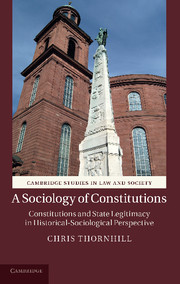 A Sociology of Constitutions
A Sociology of Constitutions Book contents
- Frontmatter
- Contents
- Acknowledgements
- A note on texts and translations
- Introduction
- 1 Medieval constitutions
- 2 Constitutions and early modernity
- 3 States, rights and the revolutionary form of power
- 4 Constitutions from empire to fascism
- 5 Constitutions and democratic transitions
- Conclusion
- Bibliography
- Index
4 - Constitutions from empire to fascism
Published online by Cambridge University Press: 07 September 2011
- Frontmatter
- Contents
- Acknowledgements
- A note on texts and translations
- Introduction
- 1 Medieval constitutions
- 2 Constitutions and early modernity
- 3 States, rights and the revolutionary form of power
- 4 Constitutions from empire to fascism
- 5 Constitutions and democratic transitions
- Conclusion
- Bibliography
- Index
Summary
Constitutions after 1848
As discussed, the revolutionary constitutions of the later eighteenth century did much to consolidate the power of central states, and in supplying the idea that the nation of rights holders was the origin of legitimate state power they greatly simplified the social abstraction and circulation of political power. The constitutions of 1848, then, consolidated the state as a broad-based body of institutions, and they at once heightened the power of states and distributed power in more even fashion through society by enunciating the principle that all members of a national society had a common and equal relation to political power. In both periods, the forming of constitutions continued a process of political distillation that had shaped most European states throughout the seventeenth and eighteenth centuries, and the patterns of liberal-national constitutional formation that culminated in the middle of the nineteenth century extended the centralistic and inclusionary impetus of earlier constitution writing. Indeed, as discussed, the liberal-national constitutional movement resulted directly from the primary state-building tendencies of the age of ‘absolutism’. Naturally, this does not imply that the constitutional models that emerged in the age of revolution did not profoundly alter the inner organization of states, and that their emphasis on popular sovereignty and rights-based self-legislation did not produce a condition of more equal legal and political inclusivity in society in which a popular legislature played an increased role in governance. However, the revolutionary constitutions of the period 1789–1848 formed a structural continuum with the administrative innovations typical of ‘absolutism’.
- Type
- Chapter
- Information
- A Sociology of ConstitutionsConstitutions and State Legitimacy in Historical-Sociological Perspective, pp. 252 - 326Publisher: Cambridge University PressPrint publication year: 2011


